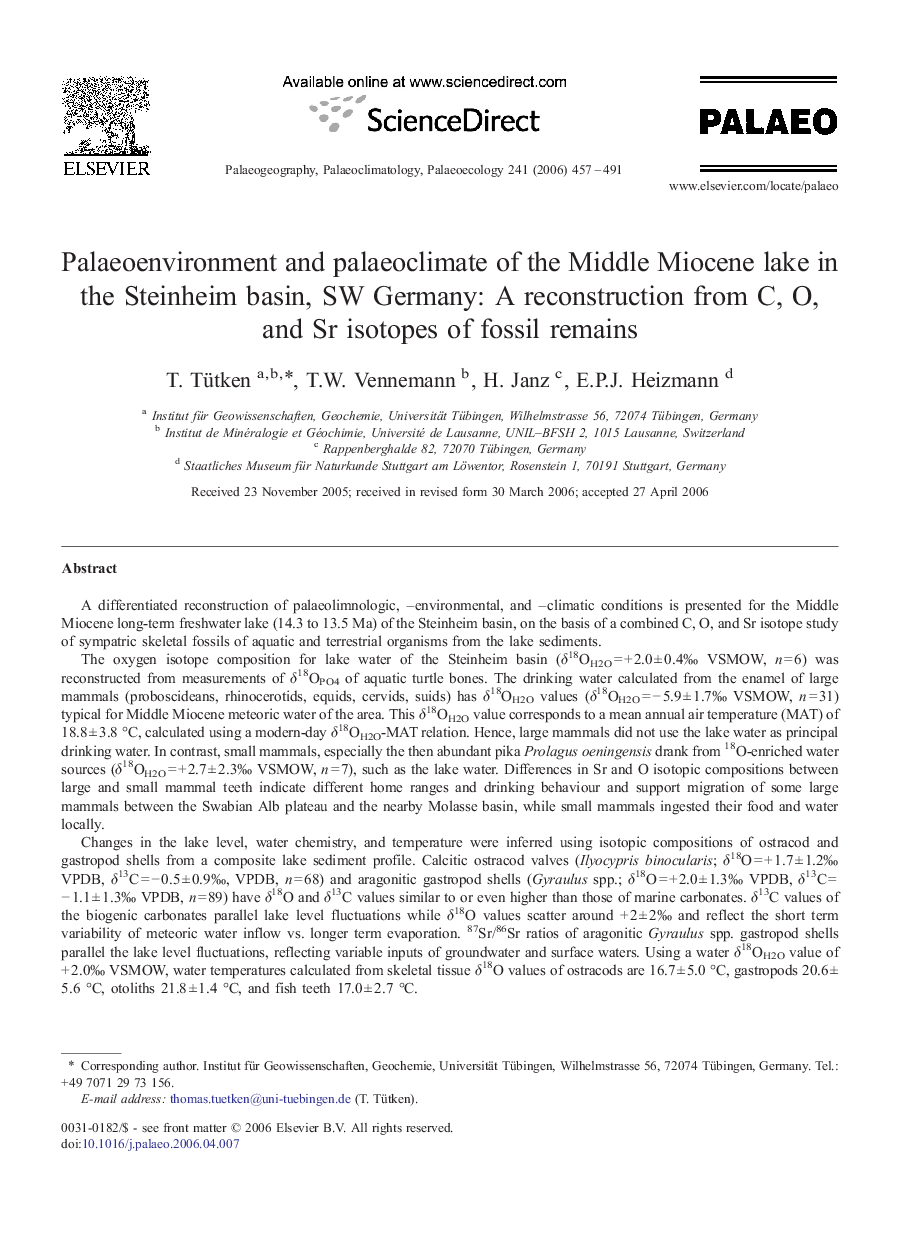| کد مقاله | کد نشریه | سال انتشار | مقاله انگلیسی | نسخه تمام متن |
|---|---|---|---|---|
| 4469205 | 1622364 | 2006 | 35 صفحه PDF | دانلود رایگان |

A differentiated reconstruction of palaeolimnologic, –environmental, and –climatic conditions is presented for the Middle Miocene long-term freshwater lake (14.3 to 13.5 Ma) of the Steinheim basin, on the basis of a combined C, O, and Sr isotope study of sympatric skeletal fossils of aquatic and terrestrial organisms from the lake sediments.The oxygen isotope composition for lake water of the Steinheim basin (δ18OH2O = + 2.0 ± 0.4‰ VSMOW, n = 6) was reconstructed from measurements of δ18OPO4 of aquatic turtle bones. The drinking water calculated from the enamel of large mammals (proboscideans, rhinocerotids, equids, cervids, suids) has δ18OH2O values (δ18OH2O = − 5.9 ± 1.7‰ VSMOW, n = 31) typical for Middle Miocene meteoric water of the area. This δ18OH2O value corresponds to a mean annual air temperature (MAT) of 18.8 ± 3.8 °C, calculated using a modern-day δ18OH2O-MAT relation. Hence, large mammals did not use the lake water as principal drinking water. In contrast, small mammals, especially the then abundant pika Prolagus oeningensis drank from 18O-enriched water sources (δ18OH2O = + 2.7 ± 2.3‰ VSMOW, n = 7), such as the lake water. Differences in Sr and O isotopic compositions between large and small mammal teeth indicate different home ranges and drinking behaviour and support migration of some large mammals between the Swabian Alb plateau and the nearby Molasse basin, while small mammals ingested their food and water locally.Changes in the lake level, water chemistry, and temperature were inferred using isotopic compositions of ostracod and gastropod shells from a composite lake sediment profile. Calcitic ostracod valves (Ilyocypris binocularis; δ18O = + 1.7 ± 1.2‰ VPDB, δ13C = − 0.5 ± 0.9‰, VPDB, n = 68) and aragonitic gastropod shells (Gyraulus spp.; δ18O = + 2.0 ± 1.3‰ VPDB, δ13C = − 1.1 ± 1.3‰ VPDB, n = 89) have δ18O and δ13C values similar to or even higher than those of marine carbonates. δ13C values of the biogenic carbonates parallel lake level fluctuations while δ18O values scatter around + 2 ± 2‰ and reflect the short term variability of meteoric water inflow vs. longer term evaporation. 87Sr/86Sr ratios of aragonitic Gyraulus spp. gastropod shells parallel the lake level fluctuations, reflecting variable inputs of groundwater and surface waters. Using a water δ18OH2O value of + 2.0‰ VSMOW, water temperatures calculated from skeletal tissue δ18O values of ostracods are 16.7 ± 5.0 °C, gastropods 20.6 ± 5.6 °C, otoliths 21.8 ± 1.4 °C, and fish teeth 17.0 ± 2.7 °C.The calculated MAT (∼ 19 °C), lake water temperatures (∼ 17 to 22 °C) and the 18O-enriched water compositions are indicative of warm-temperate climatic conditions, possibly with a high humidity during this period. Vegetation in the area surrounding the basin was largely of the C3-type, as indicated by carbon isotopic compositions of tooth enamel from large mammals (δ13C = − 11.1 ± 1.1‰ VPDB, n = 40).
Journal: Palaeogeography, Palaeoclimatology, Palaeoecology - Volume 241, Issues 3–4, 14 November 2006, Pages 457–491